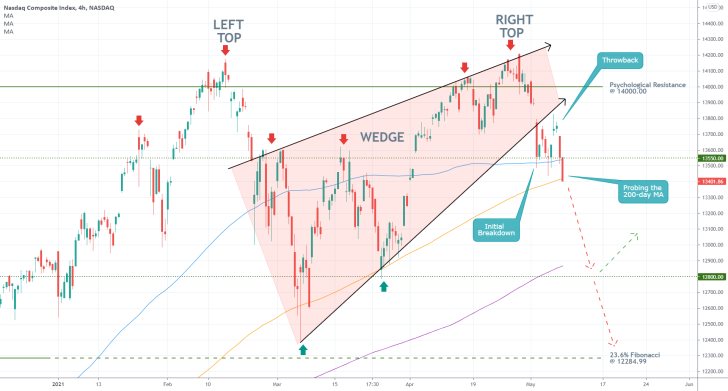
The Nasdaq composite took a sharp dive yesterday as tech stocks continue to reel from growing inflation fears. The newly developing downtrend is likely to probe even lower in the near future as the global recovery heats up.
As can be seen on the 4H chart below, this downtrend is emerging from the Double Top pattern just above the psychologically significant resistance level at 14000.00. Moreover, the breakdown occurred from an Ascending Wedge pattern, making it an even more prominent bearish movement.
The price action went on to break down below the resistance-turned-support level at 13550.00, which represents yet another major bearish indication.
Notice that the initial breakdown (below the Wedge) was held back by the 100-day MA (in blue). Afterwards, the price action established a throwback to the lower end of the Wedge from below.
Once the downturn was renewed, the price action penetrated below 13550.00 and is currently testing the 200-day MA (in orange). This floating support represents the last potential turning point for the downtrend, making it a last resort for the bulls.
Unless a major rebound takes place immediately, the price of the Nasdaq may fall as low as the next major support at 12800.00, or even the 23.6 per cent Fibonacci retracement level at 12284.99, before the IXIC finds the necessary support.
At present, there doesn't seem to be any potential catalyst in sight that could prompt such a rebound.

Growing investors' fears concerning the global trend of rapidly rising prices, particularly in the U.S., is weighing down heavily on the tech sector. Bearish pressure is ramping up despite the robust earnings season that was driving the Nasdaq higher only until recently.
Stocks are promptly losing their appeal as production costs are on the fast track to reaching growth rates that haven't been seen in over a decade. This process is accelerating ahead of the pivotal inflation data that is going to be posted this week.
Stocks face inflation risk in market with fewer reasons to rally https://t.co/hVaGqAWbFy pic.twitter.com/lp6hmWuzTf
— Bloomberg (@business) May 11, 2021
FED's massively accommodative policy stance ensures that liquidity levels would remain substantial at least until 2022, which would support inflation growth in the medium turn.
This trend can also be observed in the commodities market, as investors fleeing from the stocks bout are driving the price of gold higher.
Trendsharks Premium
Gold is undergoing a correction, as investors take profits to offset losses from falling stock prices, impacting their margins. However, we anticipate a renewed wave of [...]
The Swiss stock market index is mirroring its global counterparts, such as Germany 40 and US100, experiencing a sharp decline following the announcement of new [...]
We’re analyzing the weekly chart to grasp the broader market trend. Over the past three years, the US30 index has surged by 17,000 points, often resembling a nearly straight [...]
Over the past week, the DAX has experienced a sharp decline, plunging by an astonishing 3,400 points. This downward movement is not isolated, as its international counterparts, such as the UK100 and US100, are also facing significant [...]
EURUSD recently formed a double top at 1.0930, signaling a potential trend reversal, and has since begun a correction. After a 600-pip rally since early March, a pullback at this stage is both expected and healthy. Given these conditions, we are placing a [...]
Since early March, EURJPY has surged nearly 1,000 pips, providing us with several excellent trading opportunities. However, as the rally matures, many early buyers are beginning to take profits, leading to a noticeable slowdown in the uptrend. On Friday, the pair formed a [...]
The AUDJPY currency pair continues to be dominated by bullish momentum, as multiple golden cross patterns reaffirm the strength of the ongoing uptrend. Despite this, we are witnessing a much-needed [...]
The EURAUD currency pair appears to be undergoing a trend reversal, signaling a potential shift in market direction. A notable technical development is the formation of a Death Cross on the chart, a widely recognized bearish indicator that typically suggests a [...]
After securing an impressive 200-pip profit last week, the EURJPY currency pair is now undergoing a southward correction, retracing some of its recent gains. Despite this temporary pullback, the Golden Cross remains intact, reinforcing our view that the overall trend continues to be [...]
The appearance of a Golden Cross in Silver strengthens our analysis that the metal is currently in a strong uptrend, indicating further bullish momentum in the market. This technical pattern, where the short-term moving average crosses above the [...]
This trade presents a considerable level of risk and can be classified as an opportunistic move based on recent price action. The GBPUSD currency pair has experienced a substantial bullish rally, surging by nearly 500 pips in a strong upward movement. However, after this extended period of appreciation, the pair is showing signs of a potential [...]
The anticipated Death Cross on the SMI20 appears to be failing as price finds strong support at the 23% Fibonacci retracement level. After testing this area, the index has shown bullish strength, printing several large green candles, signaling an increase in [...]
A Golden Cross has just appeared on the USDJPY chart, signaling a potential bullish move. This technical pattern occurs when the 20 period moving average crosses above the 60 period moving average, a widely recognized indication of increasing [...]
After 2 months of a down trend, we finally see some indications of price recovery for Oil. The golden cross, a historic buy signal, supports this [...]
For the past month, the German DAX40 has experienced a remarkable 10% surge, reflecting strong bullish momentum. Despite ongoing market volatility and frequent pullbacks, every dip continues to attract fresh buyers, reinforcing the [...]
Oil continues its downward trajectory, despite occasional pullbacks. The overall trend remains bearish, reinforced by multiple Death Cross patterns, a classic sell signal indicating further weakness. Adding to this bearish outlook, the critical [...]
Over the past few days, gold has experienced a sharp decline of more than $100. This downturn can be attributed in part to traders securing profits to manage their margins, which are under strain due to the significant drop in major indices. Currently, gold has fallen below the [...]
The NASDAQ 100 index is showing strong bullish momentum, as evidenced by the formation of a Golden Cross on the chart. This classic buy signal occurs when the short moving average crosses above the long term moving average, suggesting that upward momentum is [...]
The EURAUD currency pair has encountered a significant resistance level, failing to break above the critical 61% Fibonacci retracement level. This suggests that bullish momentum is weakening, reinforcing the case for a potential downward move. Given this technical setup, we favor entering a [...]
The UK100 is experiencing a remarkable rally! Over the past few weeks, the British stock market index has surged nearly 800 points. Each minor dip has attracted more buyers, fueling the bullish momentum. However, since last week, we’ve observed a slight [...]




















